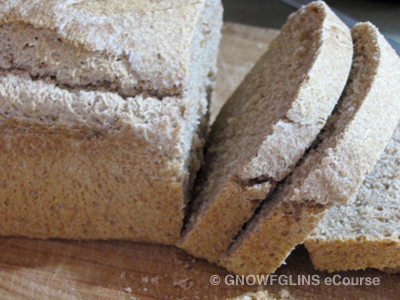 Guest post written by Wardeh Harmon from Gnowfglins.
Guest post written by Wardeh Harmon from Gnowfglins.
Not long after I began reading about sourdough, working with it myself, and teaching others to embrace it, I noticed a handful of misconceptions that come up again and again. These ideas get around somehow and they’re simply not true.
For instance, have you been told that sourdough is always sour? Do you get the impression that baking with sourdough is too hard for everyday moms who aren’t gourmet bakers? Has someone moaned that it’s super hard to keep a sourdough starter alive? Those are three of the five myths I’d like to deflate today. I’d like to set the record straight about our trustworthy and simple friend: sourdough.
1. Sourdough Is Just For Bread.
Actually, sourdough is one of the most versatile baking methods you’ll ever try. In addition to gorgeous, tasty and soft bread, you can make easy and mouth-watering sourdough pancakes, waffles, english muffins, muffins, donuts, crackers, biscuits, pot pie, gingerbread, pasta, cookies, scones, crepes, pizza crusts, tortillas, cakes, and more! I did go on and on, but you got the point, right?
2. Sourdough Is Difficult.
Not so! On the spot, you can whip up the easiest, tastiest, most nutritious pancakes, waffles or crepes with just leftover starter and a few other ingredients. For many other easy dishes, all that’s required is mixing up some starter, liquid and flour ahead of time. Then about 8 hours later you’ll create cinnamon rolls, biscuits, or pasta much like usual. So tell me, how hard does that sound?
 3. Sourdough Is Finicky.
3. Sourdough Is Finicky.
No, it isn’t. A sourdough starter, or a sour dough, has just a few basic, simple needs: oxygen, warmth, and food. And it’s not even too picky about those. Oxygen is a given; leave a loose cover on the starter or dough so it can breathe. For warmth, anything around room temperature will do. The food can come in the form of any flour you’re using at the time. Whole wheat pastry flour, whole wheat flour (red or white) and spelt flour all take turns in my starter; I feed the starter whatever I’m using for baking.
 4. Sourdough Is Just For Flavor.
4. Sourdough Is Just For Flavor.
Sourdough foods have complex and compelling flavors, no doubt. Consider the distinctive San Fransisco sour tang, or fluffy Alaskan sourdough pancakes drizzled with pure maple syrup. But I love sourdough for two other reasons.
A gift from God. Prior to this century and the development of commercial yeast, folks used a sourdough starter’s wild organisms for rising and lifting doughs. Leavened bread in the Bible? Sourdough all the way. When I see a warm soured dough rising in my kitchen, I praise God for the amazing and practical gift of sourdough.
More healthful. A sourdough starter is an ecosystem of wild yeasts and beneficial bacteria that work together to add B-vitamins to grains, to break down gluten for better digestion, and to neutralize phytic acid and enzyme inhibitors. In addition, the sourdough starter’s organisms are much more versatile than commercial yeast (with regard to temperature or other conditions) and sourdough bread doesn’t stale as quickly.
5. Sourdough Is Sour.
Sourdough can be sour, but it doesn’t have to be sour. Two chief practices contribute to “sour” sourdough.
Skipped feedings. Ideally, I believe we should feed a room temperature sourdough starter twice a day. A sourdough starter (the active mother culture) contains both wild yeasts and beneficial bacteria. Regular flour feedings keep the organisms fed and in balance. But missing a feeding gives the bacteria a leg up. You see, the yeasts run out of food when the simple sugars in flour are all consumed, and they start dying off. But the bacteria still have food to eat. They eat the expired yeasts, along with the yeasts’ wastes, and continue to produce lactic acid, the main sour flavor. And so the starter gets more sour.
Long souring period. When we create a dough with sourdough starter and let it rest, this is the souring, or fermentation, period. The yeasts and bacteria feed on the flours in the dough, and their byproducts are acids (offering flavor) and carbon dioxide (rising the dough). The longer the souring period, the more sour the flavor. For best nutrition, I recommend a good 8 hours of souring. Unless the weather is very hot, the flavor won’t be that sour, if at all. On the other hand, allowing the dough to ferment for 24 hours or more will yield a pronounced sour end product.
What can we learn from this? First, feed twice a day to keep all the organisms in balance and the overall sourness slight. Second, sour your dough for less time, rather than more.
By the way, have you heard the phrase, “soda sweetens”? It’s true! Many sourdough recipes (including these pancakes, english muffins, or waffles) call for baking soda. Not only does the baking soda react with the starter to give a good rise, but it sweetens the dough or batter by neutralizing some of the acidic taste.
Are you interested in easy sourdough recipes, video demonstrations, and mouth-watering results? I welcome you to participate in the Sourdough eCourse, where I and other teachers guide you in mastering simple, tasty, nutritious sourdough. We are always open for enrollment; you can join us any time your schedule allows. God bless you all!
 Wardeh (‘Wardee’) Harmon lives in Oregon with her husband and three children. They raise ducks and dairy goats on five and a half gorgeous wooded acres, which they are in the process of turning into a productive homestead. Wardeh’s passions are healthy cooking and sewing practical wool garments, although she loves to create just about anything from scratch, should the mood hit right. Wardeh teaches traditional and whole food cooking at the GNOWFGLINS blog and GNOWFGLINS eCourse.
Wardeh (‘Wardee’) Harmon lives in Oregon with her husband and three children. They raise ducks and dairy goats on five and a half gorgeous wooded acres, which they are in the process of turning into a productive homestead. Wardeh’s passions are healthy cooking and sewing practical wool garments, although she loves to create just about anything from scratch, should the mood hit right. Wardeh teaches traditional and whole food cooking at the GNOWFGLINS blog and GNOWFGLINS eCourse.
Wardeh have you ever dried and stored your starters? Frozen them etc.?
I started out with a commercial yeast first it was a quick rise or fast acting package I had. Used it because it was going to expire soon. I have had it for over a week now and used it to raise bread for the first time today. It raise great, no sour taste because I did not let it proof in fridge was just curious to see if I could use it in place of yeast. It works I have mad another starter from it as well. Feed them and have them in the fridge all looks good so far. Feed them several times all ready. I know commercial yeast is not recommended and may be cheating. was just wondering why is it not recommended to do this? I hope to do a non commercial starter this coming weekend and hope to have a starter that will last my children life times as well… Plan on drying and freezing some as well… I hope to try a actual sour dough this weekend with the starter I have all ready…
J-Dotson
Can I make a sourdough starter myself? Or do I need to buy it? I would prefer to make it myself.
Yes, check out Wardeh’s ecourse for great instructions. Buying a starter is just helping you get a good start and more reliable.
Thank you!!
Can you only “sour” gluten dough, or is it possible to do this with gluten free flours?
Bethany — You can do gluten-free sourdough. Some people in the Sourdough eCourse are working on adapting our recipes for gluten-free ingredients and techniques. We have a gluten-free teacher who has put together some starter and starter care materials for eCourse members, and she’s working on adapting all the recipes, too.
Another resource for you is Sharon Kane, who is a very experienced gluten free sourdough baker. Her blog is:
http://glutenfreesourdough.blogspot.com
She has a book as well, which comes highly reviewed.
Cultures for Health also sells a gluten free sourdough starter.
What a well written and informative article. Who knew yeast had wastes??? Crazy.
Isn’t it crazy, though? But it does make sense. The yeasts are eating and respirating… and they have byproducts, too.
I signed up for the course and have watched the first couple videos on starting a starter! I am a visual/ hands on learner so this is sooooo much easier than straining my brain over a book (which I have been doing and just not felt confident to actually TRY this). I really think this is going to be an answer to prayer. Thank you for sharing.
I will be starting my starter tonight
Linda — I am so glad you’ve found the videos helpful! That’s our goal — to make this doable and simple for all. Best wishes and keep in touch!
i was wondering about that same thing… what about the rest of the flour that isn’t in the sour dough start? do you need to sprout it separately? or does the sourdough take care of it all?? i’m so excited to get my sourdough start going!!
Alex — That’s a good point! You do have to be careful about many of today’s sourdough recipes, because they do not include the entirety of the flour in the “souring” stage.
On the other hand, all of my recipes, and the other recipes I feature on my blog and eCourse, have been adapted to sour all the flour. So no worries there.
These are adaptations that can be made easily once you get the hang of it.
Sheri — Hello! I like a bit of a sour taste as well.
The process of souring does eliminate the need for soaking. In addition, souring does a better job at preparing the grains for optimum digestion.
If you are going to be gone for a few days, you can store the starter in the refrigerator for a week or two. It can actually last longer in the fridge without being fed, but you can count on a week or two so that’s what I recommend.
I would like to try making sourdough someday soon. I actually like a slightly sour taste. Two questions for you: the process of souring the dough takes care of the need to soak right? Also, what do you do if you will be gone for a few days or longer. Do you need someone to “watch” your starter? How long can you go without feeding it before it goes bad?